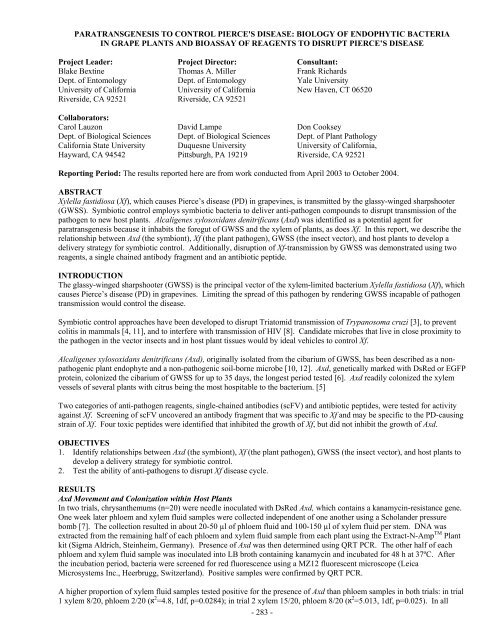Impact Of Host Plant Xylem Fluid On Xylella Fastidiosa Multiplication ...
Impact Of Host Plant Xylem Fluid On Xylella Fastidiosa Multiplication ...
Impact Of Host Plant Xylem Fluid On Xylella Fastidiosa Multiplication ...
You also want an ePaper? Increase the reach of your titles
YUMPU automatically turns print PDFs into web optimized ePapers that Google loves.
PARATRANSGENESIS TO CONTROL PIERCE'S DISEASE: BIOLOGY OF ENDOPHYTIC BACTERIA<br />
IN GRAPE PLANTS AND BIOASSAY OF REAGENTS TO DISRUPT PIERCE’S DISEASE<br />
Project Leader:<br />
Blake Bextine<br />
Dept. of Entomology<br />
University of California<br />
Riverside, CA 92521<br />
Collaborators:<br />
Carol Lauzon<br />
Dept. of Biological Sciences<br />
California State University<br />
Hayward, CA 94542<br />
Project Director:<br />
Thomas A. Miller<br />
Dept. of Entomology<br />
University of California<br />
Riverside, CA 92521<br />
David Lampe<br />
Dept. of Biological Sciences<br />
Duquesne University<br />
Pittsburgh, PA 19219<br />
Consultant:<br />
Frank Richards<br />
Yale University<br />
New Haven, CT 06520<br />
Don Cooksey<br />
Dept. of <strong>Plant</strong> Pathology<br />
University of California,<br />
Riverside, CA 92521<br />
Reporting Period: The results reported here are from work conducted from April 2003 to October 2004.<br />
ABSTRACT<br />
<strong>Xylella</strong> fastidiosa (Xf), which causes Pierce’s disease (PD) in grapevines, is transmitted by the glassy-winged sharpshooter<br />
(GWSS). Symbiotic control employs symbiotic bacteria to deliver anti-pathogen compounds to disrupt transmission of the<br />
pathogen to new host plants. Alcaligenes xylosoxidans denitrificans (Axd) was identified as a potential agent for<br />
paratransgenesis because it inhabits the foregut of GWSS and the xylem of plants, as does Xf. In this report, we describe the<br />
relationship between Axd (the symbiont), Xf (the plant pathogen), GWSS (the insect vector), and host plants to develop a<br />
delivery strategy for symbiotic control. Additionally, disruption of Xf-transmission by GWSS was demonstrated using two<br />
reagents, a single chained antibody fragment and an antibiotic peptide.<br />
INTRODUCTION<br />
The glassy-winged sharpshooter (GWSS) is the principal vector of the xylem-limited bacterium <strong>Xylella</strong> fastidiosa (Xf), which<br />
causes Pierce’s disease (PD) in grapevines. Limiting the spread of this pathogen by rendering GWSS incapable of pathogen<br />
transmission would control the disease.<br />
Symbiotic control approaches have been developed to disrupt Triatomid transmission of Trypanosoma cruzi [3], to prevent<br />
colitis in mammals [4, 11], and to interfere with transmission of HIV [8]. Candidate microbes that live in close proximity to<br />
the pathogen in the vector insects and in host plant tissues would by ideal vehicles to control Xf.<br />
Alcaligenes xylosoxidans denitrificans (Axd), originally isolated from the cibarium of GWSS, has been described as a nonpathogenic<br />
plant endophyte and a non-pathogenic soil-borne microbe [10, 12]. Axd, genetically marked with DsRed or EGFP<br />
protein, colonized the cibarium of GWSS for up to 35 days, the longest period tested [6]. Axd readily colonized the xylem<br />
vessels of several plants with citrus being the most hospitable to the bacterium. [5]<br />
Two categories of anti-pathogen reagents, single-chained antibodies (scFV) and antibiotic peptides, were tested for activity<br />
against Xf. Screening of scFV uncovered an antibody fragment that was specific to Xf and may be specific to the PD-causing<br />
strain of Xf. Four toxic peptides were identified that inhibited the growth of Xf, but did not inhibit the growth of Axd.<br />
OBJECTIVES<br />
1. Identify relationships between Axd (the symbiont), Xf (the plant pathogen), GWSS (the insect vector), and host plants to<br />
develop a delivery strategy for symbiotic control.<br />
2. Test the ability of anti-pathogens to disrupt Xf disease cycle.<br />
RESULTS<br />
Axd Movement and Colonization within <strong>Host</strong> <strong>Plant</strong>s<br />
In two trials, chrysanthemums (n=20) were needle inoculated with DsRed Axd, which contains a kanamycin-resistance gene.<br />
<strong>On</strong>e week later phloem and xylem fluid samples were collected independent of one another using a Scholander pressure<br />
bomb [7]. The collection resulted in about 20-50 µl of phloem fluid and 100-150 µl of xylem fluid per stem. DNA was<br />
extracted from the remaining half of each phloem and xylem fluid sample from each plant using the Extract-N-Amp TM <strong>Plant</strong><br />
kit (Sigma Aldrich, Steinheim, Germany). Presence of Axd was then determined using QRT PCR. The other half of each<br />
phloem and xylem fluid sample was inoculated into LB broth containing kanamycin and incubated for 48 h at 37ºC. After<br />
the incubation period, bacteria were screened for red fluorescence using a MZ12 fluorescent microscope (Leica<br />
Microsystems Inc., Heerbrugg, Switzerland). Positive samples were confirmed by QRT PCR.<br />
A higher proportion of xylem fluid samples tested positive for the presence of Axd than phloem samples in both trials: in trial<br />
1 xylem 8/20, phloem 2/20 =4.8, 2 א) 1df, p=0.0284); in trial 2 xylem 15/20, phloem 8/20 =5.013, 2 א) 1df, p=0.025). In all<br />
- 283 -











